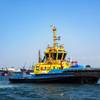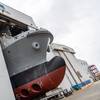When the cold September sea reached out her icy fingers to claim fisherman John Roberts, a plastic boat in a cozy British pub came to his rescue.
Just as Roberts began to think he would succumb to the Atlantic's numbing clutches, his spirits were buoyed by the sound of flares going off above the Royal National Lifeboat Institution (RNLI) station in his home port of Sennen Cove. "When I heard those two bangs and knew what they were, then I knew somebody was coming for me," said the 53-year-old veteran of England's treacherous southwestern coastal waters. Roberts insists he owes a debt of gratitude to the RNLI and the Royal Navy helicopter that plucked him from the sea.
However, humble crewmen say that his thanks should go to the millions of people who faithfully pop donations into the RNLI's plastic lifeboat-shaped money boxes in pubs across Britain and Ireland. The ubiquitous blue-and-white lifeboat replicas are enduring symbols of the 175-year-old RNLI, the world's oldest nationwide coastal rescue service and one of only two such organizations in the world that is entirely reliant on charity.
"That's about 80 million pounds ($132 million) a year in donations and they always get it," said Sennen Cove RNLI coxswain Terry George.
Coast-To-Coast Coverage
For its money, the ocean-going public is served by 223 lifeboat stations covering 14,000 miles (22,530 km) of coastal waters from Scotland's Orkney Isles in the north to the Scilly Isles at England's southwestern tip and all of Ireland.
Since the RNLI's inception in 1824, the lifeboats have saved nearly 133,000 lives. In 1998 alone, the service saved an average of four lives a day and assisted 6,574 people.
Down in Sennen Cove, George and his 23 volunteers use the money they receive to keep their twin-engine, steel-hulled lifeboat ship shape and kitted out with the latest radar, communications, satellite navigation and safety equipment. Each member is issued with a pager, lifejacket, helmet, dry suit, boots, harness and other pieces of all-weather kit.
All that modern gear would be a surprise to the RNLI's aristocratic founder Sir William Hillary, whose 1823-written "Appeal to the Nation" was the first call for public support. Hillary's campaign for a national lifeboat service culminated on March 4, 1824, in the creation of the National Institution for the Preservation of Life from Shipwreck. The name was changed to the Royal National Lifeboat Institution in 1854.
Although the gear has improved from the days when mariners in oilskins and sou'westers battled tempestuous seas in open rowboats, the job remains terrifyingly dangerous.
One of the worst disasters happened a stone's throw from Sennen Cove's picturesque beaches on Dec. 19, 1981, when the entire crew of the Penlee lifeboat from the Cornish village of Mousehole perished. Local crews still refuse to talk about how the bodies of some of the sailors were washed ashore after the Penlee boat was smashed while trying to rescue people from a foundering ship in hurricane-force winds and six-story waves.
Relatives of crew members in the surrounding area worry about their loved ones every time a flare goes off or the ever-present pagers begin to beep. "Nearly every time they go out and it's rough, you are anxious until they come back," said Sally Thomas, whose 30-year-old son Andrew is a member of the Sennen Cove crew.
Community Service Main Reason For Bravery
Like most of Britain's lifeboat crews, Sennen Cove has one full-time paid employee.
George is both coxswain (the helmsman of the ship and coordinator of the crew) and mechanic. A former fisherman, he says he joined the lifeboat service out of a sense of duty.
His crew -- a collection of surfing instructors, firemen, fishermen and pub workers -- receive a small stipend each time they are called out but say community service is the main reason for their bravery.
Sennen Cove, about five miles (eight km) from Land's End at the southwestern tip of Cornwall, is the point where tides from the English Channel and the Bristol Channel clash. Jagged rocks jut dangerously out of the sea.
Sennen Cove's crew includes 25-year-old surfing instructor Nan Beason, one of 200 women serving alongside the RNLI's 4,000 male crew members. "I guess I joined for the adventure and to help people," she said. Beason follows in the legendary footsteps of Victorian heroine Grace Darling, an English lighthouse keeper's daughter, famed for rescuing survivors from a wrecked steamer in 1838.
Like Darling, Beason and all the RNLI volunteers will go without sleep or food, run out on weddings or dash from work in the race to save the lives of stricken seamen.
Roberts said that after his rescue from the sea in September, the Sennen Cove crew even returned his fishing boat to its usual overnight spot while he was in the hospital recovering from hypothermia.
"Even though that's not part of the lifeboat service, it's nice to know that people will turn up to help when something goes wrong," he said. - (Paul Casciato, Reuters)
Sponsored Content
Safer Starts Here: Build Ships, Protect Crews

Featured videos

Corn Belt Ports Streamlines Critical Agriculture River Shipments

Cat Pushes Forward on Hybrid Electric Solutions, Alternative Fuels

“One Man, One Wrench” Launched a Global Maritime Power Play
July 2025
 Read the Magazine
Read the Magazine

 Read the Magazine
Read the Magazine
This issue sponsored by:

Inside the U.S. Navy: The Fleet has to get Bigger, and that’s a Big Challenge
Subscribe for
Maritime Reporter E-News
Maritime Reporter E-News is the maritime industry's largest circulation and most authoritative ENews Service, delivered to your Email five times per week







